
When the 116th Congress adjourns, sometime before January 2021, Tennessee’s 80-year-old senior senator, Lamar Alexander, will retire after three full terms. No one living today has had more far-reaching influence on American K–12 education. As we wish him many glorious years of retirement, we do well to recognize that his legacy will last even longer. That’s in no small part because his work in the realm of education, and in others, adhered to a consistent and effective vision of leadership. Lamar followed some simple advice that he had found in a book about the presidency by LBJ press secretary George Reedy: a leader should “do three things: 1) see a few urgent needs, 2) develop a strategy to meet each of those needs, and 3) persuade at least half the people that he is right.”
Known to those who have worked with him simply as “Lamar,” the senator is renowned for his approachability and affability as well as his intellect, steadfast pursuit of the public interest as he construes it, and insistence on “getting things done.” In recent years on Capitol Hill, he has stood as one of the few representatives of an older and more honorable era of constructive bipartisanship. In 2011, as Congress was growing more polarized and partisan, Lamar voluntarily exited the ranks of Senate Republican leadership, where he was a rising star, explaining that doing so “will liberate me to spend more time working for results on the issues I care most about. I want to do more to make the Senate a more effective institution so that it can deal better with serious issues.”
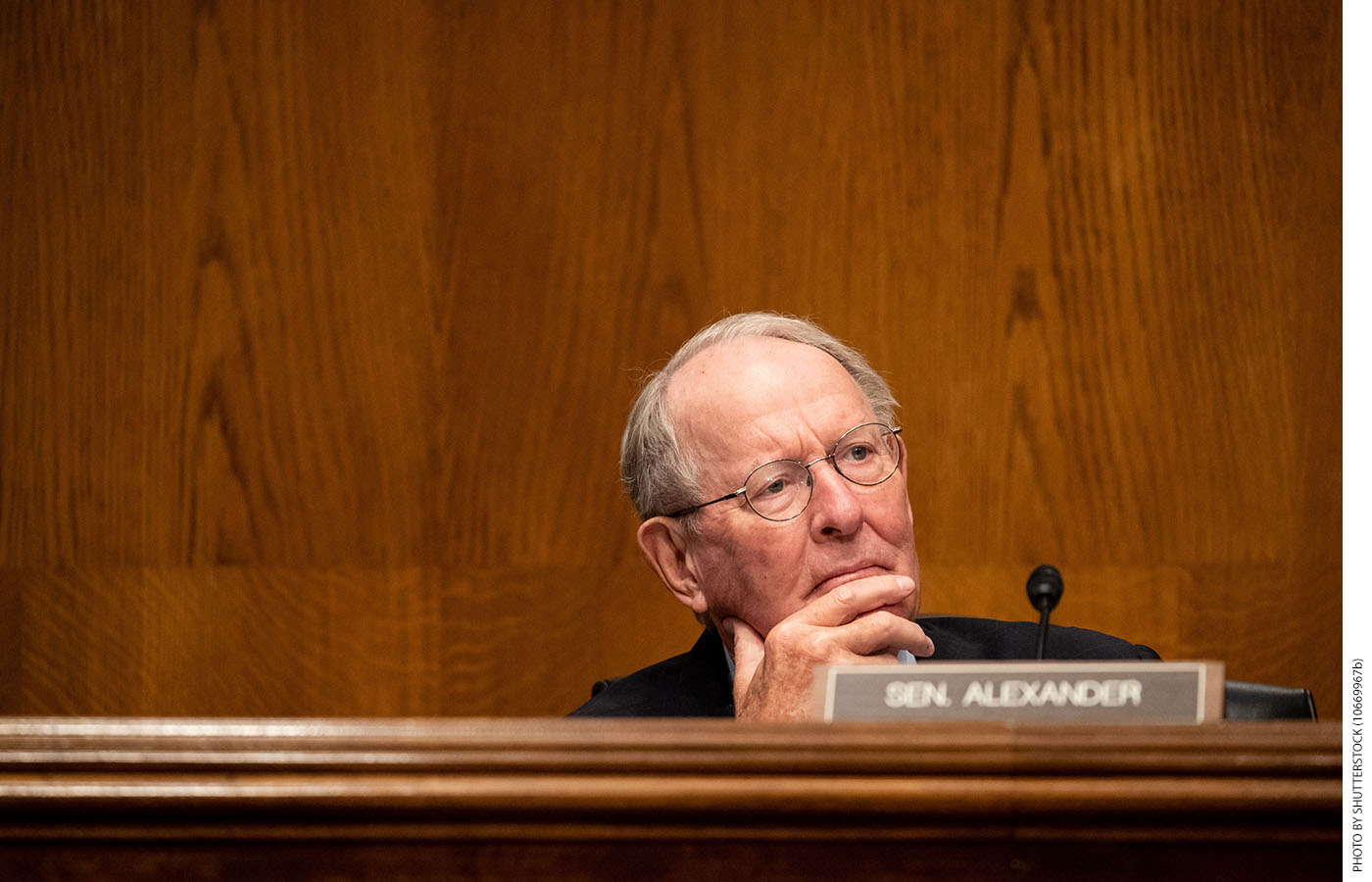
Instead of waiting to become an admiral, Lamar opted to captain a battleship. While serving on four Senate committees and 10 subcommittees, Lamar focused primarily on his chairmanship of the Committee on Health, Education, Labor, and Pensions, known as the HELP Committee. During his four years in that chair, the committee reported out some 45 separate bills that were enacted into law, a remarkable accomplishment in this fraught era on Capitol Hill. Working effectively across the aisle with Senator Patty Murray of Washington, the committee’s ranking Democrat, he advanced signal legislation on primary-secondary education, including 2015’s Every Student Succeeds Act and 2018’s reauthorization of the Carl D. Perkins Career and Technical Education Act. Last year, he and Murray agreed on a bill to simplify the notorious FAFSA undergraduate financial-aid application with which 20 million families wrestle each year and to permanently fund historically Black colleges and universities. As I write, he’s doing his darnedest to get those reforms across the congressional finish line.
This legislative activity, however, is just the latest, and perhaps not the final, act in Lamar Alexander’s half-century performance on the education stage.
Education and Early Career
Lamar was born in east Tennessee in 1940. Andrew Lamar Alexander, Lamar’s father, was an elementary-school principal until, needing to earn more to support his growing family, he went to work for Alcoa. Still passionate about education, he then ran for the Maryville City School Board, on which he served for 25 years, some of that time as chair.
For three decades, Lamar’s mother, Flo Alexander, ran and taught in a preschool housed in a converted garage behind their home. It was one of the few pre-K options available in Maryville at the time, ages before public-school kindergartens and Head Start. As Lamar recalls, “She had nowhere else to put me except in ‘Mrs. Alexander’s Nursery School and Kindergarten’ for five years, so I had quite a head start.” A head start indeed for a career that, while not based in education, has never been far from it. “The point is,” he says, “I was taught and experienced the value of a good education.”
That education later took him from Maryville High School to Vanderbilt University in Nashville, where he became an accomplished student athlete, earned top grades, and graduated Phi Beta Kappa in 1962. Even in college, he showed a willingness to swim upstream if the destination was important to him. He used his platform as editor of the student paper to oppose the university’s racial segregation that most of his classmates supported. The New York Times once characterized him as “quietly subversive.”
Lamar went on to New York University Law School, where he participated in the law review and excelled academically. Afterwards, he served as a clerk for Judge John Minor Wisdom of the Fifth Circuit and then as legislative assistant to Tennessee GOP Senator Howard Baker, who became something of a mentor to Lamar.
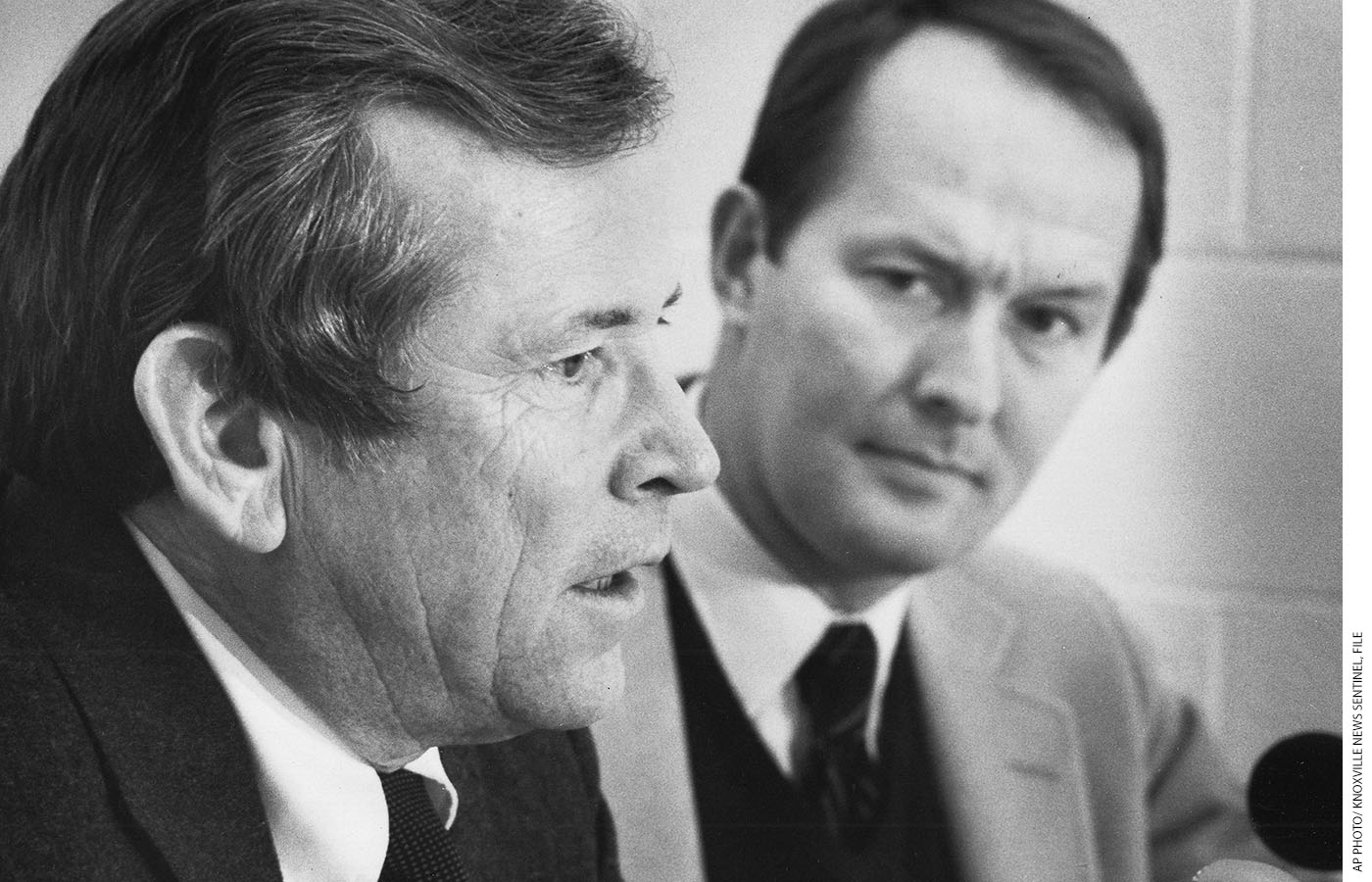
In 1969, he joined the staff of the Nixon White House, where he and I first met, both still in our 20s. Lamar was an aide to Bryce Harlow, who headed congressional relations for Nixon, and I was on the team led by White House Urban Affairs Adviser Daniel Patrick Moynihan. Before long, though, Lamar and his new bride, Leslee Buhler (known to all as “Honey”), returned to Tennessee, where he practiced law and entered politics in his own right. After one false start, he won a bid for governor in 1978 at the age of 38. At that point, I was again working for Pat Moynihan, by then a Democratic senator from New York, but three years later my wife and I found ourselves en route to—of all places—Nashville, where I would join the Vanderbilt faculty.
An Education Governor
When Lamar became governor, the Volunteer State had the third-lowest average family income in the land. In his inaugural address, he declared, “My goal is to raise family incomes.” He soon concluded that the surest way to boost his state’s drab economic prospects was to revitalize its education system. In what became an oft-repeated slogan, he maintained that “better schools mean better jobs for Tennesseans.”
For a Republican governor, getting anything important done in purplish Tennessee meant joining forces with leaders of the Democratic legislative majority. So, in 1981, Lamar joined with those leaders to appoint a blue-ribbon commission that would explore ways of improving the state’s schools and colleges. The state bought enough Mac computers for every middle school to add computer literacy to its curriculum. With occasional convening help from the Southern Regional Education Board, which for a time Lamar chaired, he also connected regularly with his counterparts in other states. Arkansas’s Bill Clinton, South Carolina’s Dick Riley, and Florida’s Bob Graham, “education governors” all, had been elected the same day as Lamar. He also started quietly exploring the concept of merit pay for teachers. (From my Vanderbilt desk, I helped a bit with that part.)
At the time, Lamar viewed education as properly and entirely a state responsibility. He flew to Washington in 1981 to propose to President Ronald Reagan a “grand swap,” whereby Uncle Sam would shoulder the whole Medicaid burden while offloading all of K–12 education onto the states. Reagan mentioned the idea in his 1982 State of the Union address, and, in retrospect, such a sorting-out might have been good for all concerned, but it never happened.
That didn’t deter Lamar from mounting his own state-specific reform proposal. In a January 1982 “State of Education” address, he set out a five-year Basic Skills First plan that included elements of academic standards, tests, and accountability, all new to Tennessee and to most of the country. But this was just the start. A year later, with the bipartisan commission report and his own reelection in hand, he presented the state’s lawmakers and educators with a 10-point Better Schools Program.
That proposal was comprehensive, ambitious, expensive, and, in one key element, truly bold. It emphasized basic skills, computer literacy, stronger adult and vocational education, summer residential programs for gifted high schoolers, and a substantial investment in university “centers of excellence,” but the heart of the plan was an innovative and intricate merit-pay design called the Master Teacher Program. This was structured as a “career ladder” by which existing Tennessee teachers who chose to join—and all future teachers—could, on the basis of performance, ascend four levels of professional licensure and stature, with considerably higher pay attached to each level. The plan was ultimately enacted, becoming the first statewide program in the nation to, in Lamar’s words, “pay teachers more for teaching well.” And because student performance as demonstrated by test scores was to be one of several factors in gauging teachers’ readiness to ascend the ladder, it paved the way for what we now know as “growth” or “value-added” analysis of student, teacher, and school performance.
Getting the plan adopted, however, involved an epic legislative battle, because the Tennessee Education Association and its parent, the National Education Association, hated the merit-pay part of the program, though it generally supported the rest, including the additional education funding that would be provided by the sales tax boost the governor had proposed.
Lamar Alexander is politically adroit as well as famously dogged in pursuit of purposes and plans he believes in. In his 1978 quest for the governor’s office, he walked more than a thousand miles across the state. He proved tireless and imaginative in pressing for the Better Schools Program, both within Tennessee and beyond. For example, he and I took the state plane to Washington and had lunch with Albert Shanker, president of the American Federation of Teachers. Shanker was keener on finding ways to encourage and reward great teachers than were his Tennessee counterparts in the rival NEA. Shanker then invited Lamar to address the AFT’s annual convention in Los Angeles. (Flo Alexander said, “Be careful, son.”) Shanker, in introducing Lamar to union members, asked them, “If you can have master plumbers, why not master teachers?” Lamar’s speech drew a standing ovation from the union delegates.
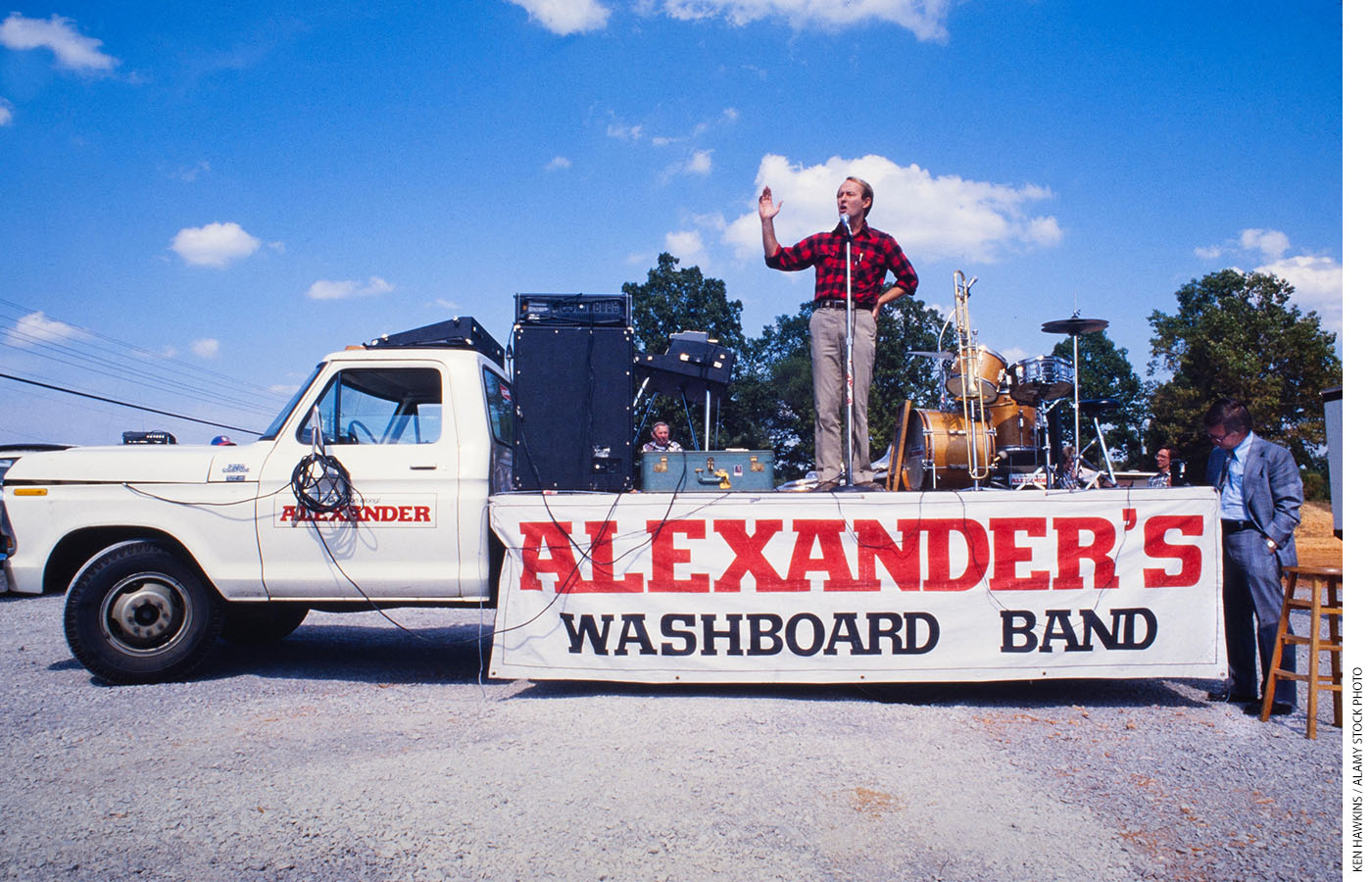
Lamar and his team spent many hours on public events, rallies, and lobbying legislators and those who might influence them. Most of the Better Schools Program was broadly popular, despite its hefty price tag, but the Master Teacher Program proved a heavy lift. The whole reform enterprise gained traction, however, from the coincidental fact that 1983 also saw the publication of the National Commission on Excellence in Education’s landmark report A Nation at Risk, which drew attention to the dire state of K–12 education in America and heralded an “imperative for educational reform” in its subtitle. Hard as it is today to recall such a time, it was also a period of bipartisan zeal for such reforms. The Clintons were overhauling education in Arkansas. Dick Riley and Jim Hunt were doing the same in the Carolinas, as was Tom Kean in New Jersey. Like Lamar, Florida’s Democratic governor Bob Graham was struggling—successfully, in the end—to create a merit-pay plan for the Sunshine State, and though he and Lamar engaged in a friendly rivalry to see who could get there first, Graham came to Nashville to urge a key state senator to vote for Lamar’s plan. Reagan came too, visiting Knoxville’s Farragut High School to voice his support for the Master Teacher Program and help legitimize the funding to pay for it.
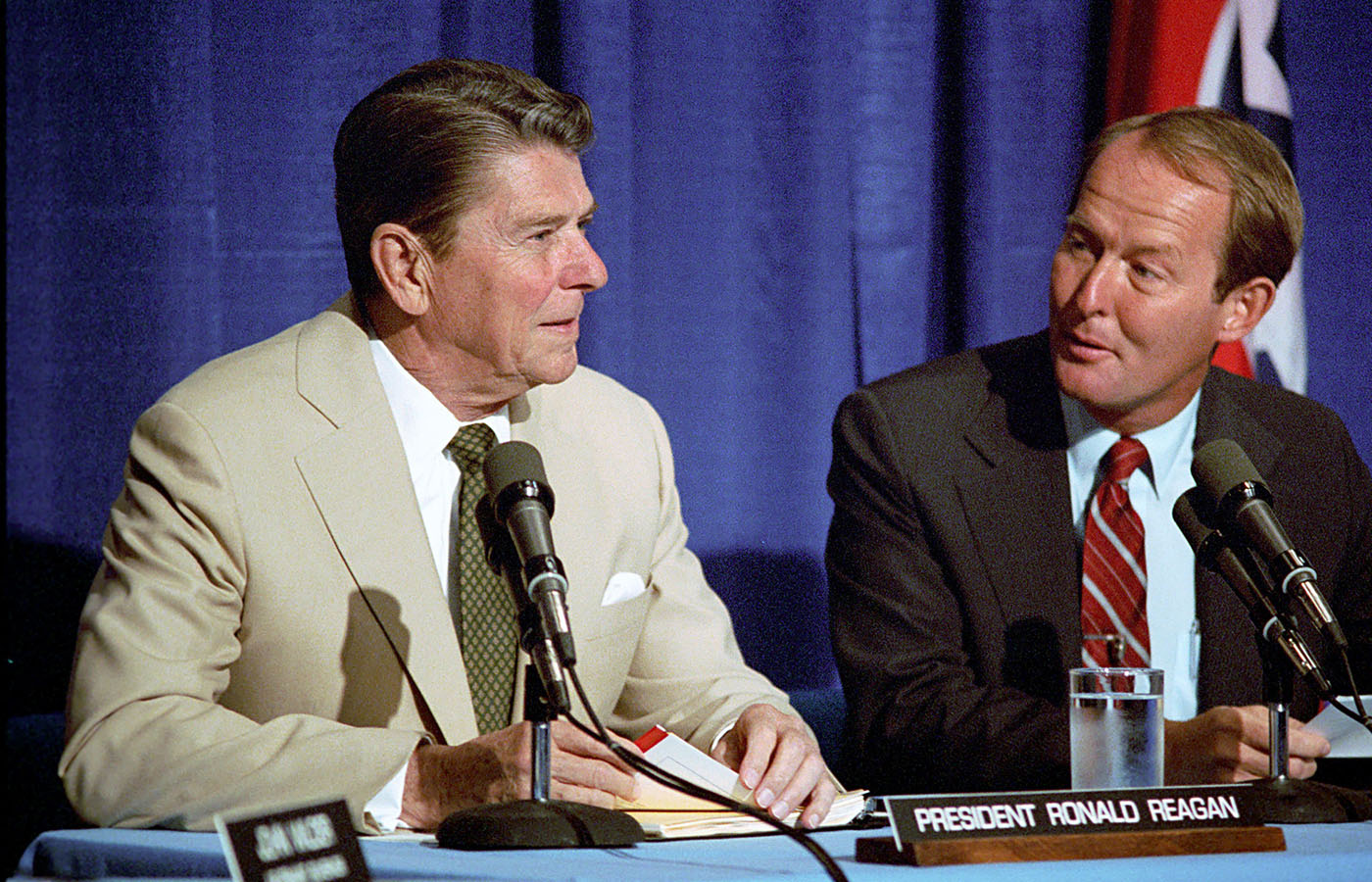
After a lot more advocacy work, some compromising with the union, and summoning the legislature into special session, a mostly complete version of Alexander’s Better Schools plan was enacted in February 1984, along with a one-cent increase in Tennessee’s sales tax.
Lamar had much to be proud of but was already looking for more, and not just in Tennessee. He helped lead the Southern Regional Education Board into a pioneering use of data from the National Assessment of Educational Progress, or NAEP, to generate state-level results, which had never been done before. He journeyed to Dallas to try to convince Ross Perot, who had been deeply involved in Texas education reform, to join him in a nationwide “better schools effort.” Perot demurred, telling Lamar that education reform was the “meanest, bloodiest, and most difficult thing I’ve ever done” and that he wanted no more of it. As chairman of the National Governors Association, Lamar persuaded that group to spend an entire year on a single topic, namely better schools, which ushered in what became a five-year Time for Results project that enlisted governors from many states.
Along the way, Lamar developed two lasting convictions about K–12 education. Within Tennessee, Lamar came to understand that, regardless of what the state might do, schools wouldn’t get much better unless their communities wanted them to, which often meant cultivating an appetite for change from outside the usual school establishment. This prompted him to travel the state to urge creation of what became “better schools task forces” in every one of Tennessee’s 127 districts. Lamar came to understand that public schools ultimately express the educational priorities, dreams, and capacities of their communities, and that, while state and federal governments—and other external forces—can influence, inspire, and assist in various ways, the quality of the school supply won’t improve unless there’s local demand for it.
Lamar expressed the second emerging conviction in 1986 when Education Week asked him what common thread ran through the seven task force reports that the National Governors Association’s “time for results” initiative had produced. “The governors,” he said
are ready for some old-fashioned horse-trading. We’ll regulate less, if schools and school districts will produce better results. The kind of horse-trading we’re talking about will change dramatically the way most American schools work. First, the governors want to help establish clear goals and better report cards, ways to measure what students know and can do. Then, we’re ready to give up a lot of state regulatory control—even to fight for changes in the law to make that happen—if schools and school districts will be accountable for the results.
These remarks reflected not only his single-minded focus on better results and a solid grasp of the need for standards, assessments, and accountability, but also his belief in a reform strategy that offers freedom and flexibility in return for outcomes. Don’t tell people how to run their schools; instead, insist that students learn more and hold the schools and those who run them responsible for delivering results.
Watershed Moment
As Lamar neared the end of his second term as governor and prepared to move his family to Australia for what turned into a six-month sabbatical, I was back in Washington working with Bill Bennett at the U.S. Department of Education. It was evident that NAEP needed an overhaul, if only to give states the achievement data that governors now craved but could not get in reliable fashion from either SAT and ACT scores or the minimum-competency tests their own schools typically used. We understood that any such overhaul would need bipartisan support; a proposal from the Reagan administration alone would not fly with a Congress that had a solid Democratic majority in the House and would soon have one in the Senate.
Our strategy, then, was to appoint a blue-ribbon “study group,” with distinguished members from both parties and from the education and ed-reform camps, and have it function—with foundation funding—largely outside the government itself. Lamar agreed to chair the group, if we enlisted someone else to do the heavy lifting. Fortunately, H. Thomas James, the just-retired president of the Spencer Foundation and former Stanford ed-school dean, was game to serve as vice chair and orchestrate the work.
We assembled a diverse group of educators, public servants (including Hillary Rodham Clinton, then first lady of Arkansas), business leaders, and academics. In March 1987—while Lamar was Down Under—the panel presented its report. Education Week termed it a plan for “a radically more ambitious and expensive version of the nation’s ‘report card’ on student achievement.” (It was Lamar who coined the nickname “nation’s report card” for NAEP. He has an instinct for the kind of language that works best in the public square.)
It was a watershed moment, not just for NAEP but also for America’s capacity to monitor the performance of its K–12 system. As panel member Michael Kirst of Stanford said at a press conference introducing the report, “What is being discussed today wouldn’t even have been considered 20 years ago. Anyone who had proposed it would have been laughed out of the room.” Albert Shanker declared that strengthening NAEP was “one of the most important things we can accomplish in this round” of education reform.
The stickiest wicket was the recommendation that NAEP report “achievement in each of the fifty states and the District of Columbia,” which the panel termed “the single most important change” it was recommending. But the glacier of resistance to such reporting was already cracking, in no small part because Lamar and his fellow governors had applied heat to it. In the aftermath of A Nation at Risk, the only state-level data available from the Education Department came from Secretary Terrel H. Bell’s so-called wall chart, which relied on unrepresentative SAT and ACT scores. Yet the Southern Regional Education Board’s pilot program showed that NAEP could serve this purpose. The National Governors Association’s Time for Results project added to the demand. The Alexander-James panel pointed the way to an improved supply. Lamar had played a key role in nearly every phase of this shift.
He, however, was entering a couple of years in private life, writing, doing some college teaching, and raising his still-young family. He reemerged in 1988, when he became president of the University of Tennessee. Soon thereafter, he was drawn back into the national K–12 reform effort.
Zeal for Reform
In 1989, President George H. W. Bush convened an education “summit” in Charlottesville, Virginia, attended by 49 governors. The event produced a hugely ambitious set of national education goals to be achieved by the year 2000. Bush and his staff earnestly wanted an action plan to accompany these goals, but they weren’t getting much action from the Education Department, then headed by Lauro Cavazos, a reticent university president who was the first-ever cabinet member of Hispanic descent. So they created the President’s Education Policy Advisory Committee, known as PEPAC, led by Alcoa CEO and future Treasury secretary Paul O’Neill and including New Jersey’s Tom Kean, Xerox’s David Kearns, and Lamar, among others (myself included) who the White House hoped would put some wind in the sails of the man who had declared himself America’s first “education president.”
PEPAC did some of that—one meeting also afforded Bush a degree of “cover” on the day bombs started falling on Baghdad as part of Operation Desert Storm—but by the end of 1990, Cavazos was being shown the door. A week before Christmas, Bush nominated Lamar to take Cavasos’s place as secretary of education. Lamar soon began to formulate the action plan Bush craved. I was part of the team Lamar assembled—along with Kearns, Bruno Manno, and Scott Hamilton—to brainstorm what became America 2000.
Bush welcomed that plan, and in April 1991, the White House released it. As reported in Education Week,
President Bush and Secretary of Education Lamar Alexander last week unveiled an ambitious, unprecedented “education strategy” highlighted by proposals for “a new generation of American schools” and a national system of high-stakes achievement testing. “For the sake of the future, of our children, and our nation, we must transform America’s schools,” Mr. Bush told business leaders, governors, lawmakers, and educators at the White House last Thursday. “This isn’t really an announcement; it’s a launch,” Mr. Alexander told reporters. “It isn’t really a program; it’s a crusade.”
America 2000 kicked off the modern era of federal involvement with K–12 education reform. In contrast to a standard-issue government program, much of America 2000 was intended to take place in the private sector and voluntarily in hundreds of communities that would avail themselves of innovative school models and sundry other ideas and mechanisms for working toward the national education goals. Still, many observers came to see America 2000 as the start of a decade of heavy federal involvement, especially in combination with the National Education Goals Panel that emerged after Charlottesville, the revamped National Assessment, and a National Council on Education Standards and Testing that was congressionally chartered but largely appointed by Alexander. That decade would culminate in No Child Left Behind, followed by Race to the Top and the Common Core.
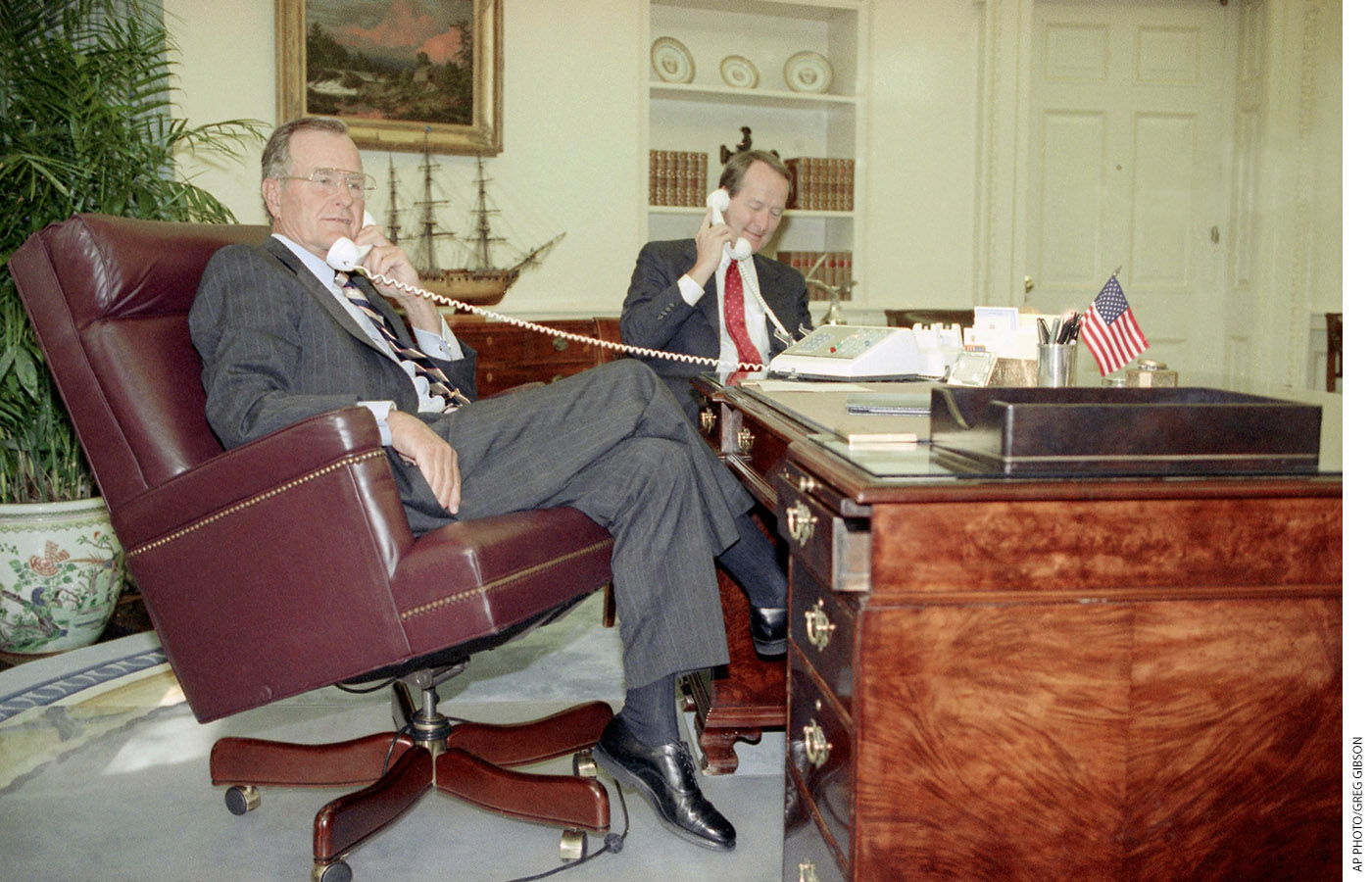
The Democratic Congress had little stomach for the parts of the Bush-Alexander plan that called for legislation (including measures to boost school choice and further expand NAEP into “voluntary national tests”). The executive branch—and a host of private donors and education entrepreneurs—did their best, though, to advance the rest. Lamar’s Education Department and Lynne Cheney’s National Endowment for the Humanities made grants to organizations to develop national standards for core subjects. Much of that work was overseen by Diane Ravitch, then assistant secretary of education. As deputy secretary of education, David Kearns raised private money for the New American Schools Development Corporation, which in turn seeded a number of start-from-scratch school designs. And Lamar barnstormed the country with the president, appearing with both GOP and Democratic governors to promote their “crusade” in one state and community after another. Speaking in Columbus in November 1991, for example, Bush proudly declared that, seven months in, Ohio had just become the 25th state to “have enlisted in the revolution to reinvent American education by the dawn of the new century.”
Nor did their zeal for education reform stop there. With Minnesota and California having passed charter-school laws and Wisconsin having launched a small voucher program in Milwaukee, school choice was gaining momentum, and Bush and Lamar sought to add a federal nudge. So, in June 1992—with his reelection campaign underway—the president sent Congress a Lamar-designed “GI Bill for Children” that would provide federal funds to states and communities that wanted to make private-school scholarships (that is, vouchers) available to families. Lamar has revived, resubmitted, and promoted variations of this plan ever since, though resistance from teachers unions, their Democratic allies, and more than a few suburban Republicans has so far blocked all such moves.
By then, however, he was also beginning to see how difficult it was—and remains today—to sustain the distinction between “national” and “federal” and to maintain a workable barrier between voluntary and mandatory. He had long denounced the trend toward a de facto “national school board” that would usurp state and local control, but that trend was acquiring momentum.
The essential distinction seemed clear enough to Lamar. Testifying to the Senate in support of America 2000, he declared that “the federal role is to cause someone else to do it.” Though Washington’s role was “limited,” he wrote in the key America 2000 pamphlet, “that role will be played vigorously. Washington can help by setting standards, highlighting examples, contributing some funds, providing flexibility in return for accountability, and pushing and prodding—then pushing and prodding some more.” Top government officials would also deploy their education bully pulpits as best they could—ample precedent for this had been set during Bennett’s time as education secretary and, in somewhat different ways, by Ted Bell and Ronald Reagan. But Washington wouldn’t do the reforming itself. States and communities ultimately had to want to do it and would inevitably do it their own way, and some of them would do it poorly or not at all. That’s American federalism, at least in K–12 education. Save for civil rights protections, the national government had no business telling people how to run their schools, much less trying to force them to.
As Lamar would put it in a speech decades later, “A national issue is an urgent concern for the whole country. A federal issue is something Washington is in the best position to solve.”
One can argue that, at the outset, Alexander and Bush didn’t do a great job of emphasizing that distinction. As critic David Whitman reconstructed those events in a 2015 Brookings paper, “Lamar Alexander didn’t quite summon the federal government to the barricades. But he did say that America 2000 would require ‘major change in our 110,000 public and private schools, change in every American community, change in every American home, change in our attitude about learning.’ And he hit the road to proselytize for his America 2000 plan.”
Yet the line Lamar was trying to draw began to get crossed when the National Council on Education Standards and Testing that he had largely appointed—I was a member—issued its report in January 1992, just eight months after America 2000 was unveiled. Besides recommending national academic standards and a complex move toward national testing—all of which Lamar welcomed—the council framed a set of “school delivery” standards, that is, standards for school inputs and practices. Though the panel had signaled that states should do this for themselves as part of a comprehensive approach to reform, Congress had other ideas. Encouraged by teachers unions and others in the school establishment, the Democratic leadership in the House, in its own very different version of America 2000 legislation, reframed the council’s recommendations as federal “opportunity to learn” standards.
Lamar saw this move as an emerging “national school board that could make day-to-day school decisions on curriculum, discipline, teacher training, textbooks, and classroom materials.” This led him, in September 1992, to warn House minority leader Bob Michel that he would urge Bush to veto the measure if it retained these features. “Such decisions,” Lamar wrote, “belong with communities, parents, teachers, and local school boards. A federal recipe book dictating how to operate a local school does not make schools better.”
Weeks later, Bill Clinton beat Bush, and in early 1993, Lamar returned to Tennessee as his friend, former South Carolina governor Dick Riley, moved into the secretary’s office.
After that, the movement toward a “national school board” accelerated. Under Clinton, 1994’s Goals 2000 and Improving America’s Schools acts moved the federal government forcefully toward requiring states to set academic standards, administer regular assessments to every child, and work toward uniform national goals. Those goals had burgeoned from the six that had been set in Charlottesville, one of which identified five core subjects, to eight goals and nine subjects. Though the detailed mandates of No Child Left Behind were still seven years in the future, Lamar was alarmed by the direction Washington was taking. When he threw his hat into the ring for the 1996 GOP presidential nomination, he vowed that, as president, he would “let parents and teachers make decisions about education. I will abolish the Department of Education and then create a GI Bill for Kids so that parents won’t be forced to send their children to a bad school.”

He sought the presidency again in 2000 but bowed out after a poor showing in Iowa. After a year at the Harvard Kennedy School (as “professor of practice”), Lamar returned to politics, this time back in Tennessee, and in 2002, was handily elected to the U.S. Senate, taking the seat vacated by Fred Thompson.
Senator Alexander
Lamar’s interest in education had not waned. He immediately sought (and got) membership on the HELP Committee, where he would soon chair the subcommittee on children and families, which is responsible for education legislation. His maiden speech on the Senate floor explained the American History and Civics Education bill he was introducing. “It is time,” he said, “that we put the teaching of American history and civics back in its rightful place in our schools.” He approvingly recalled a 1988 forum at which Shanker answered the question “What is the rationale for the public school?” by saying, “The public school was created to teach immigrant children the three R’s and what it means to be an American with the hope that they would then go home and teach their parents.”
It was 18 months after 9/11, and Lamar’s appeal to American exceptionalism and patriotism was timely and understandable. His bill, however, was no “big government” measure. Intended to piggyback on a George W. Bush initiative at the National Endowment for the Humanities, it would authorize competitive grants to educational institutions to operate summer programs for history and civics teachers and for interested students. It was, in other words, entirely consistent with Lamar’s view that the federal role is to encourage, facilitate, and inspire.
When he entered the Senate, No Child Left Behind had been law for barely a year. Asked about NCLB during an interview for this article, Lamar wasn’t sure he would have voted for the bill had he been in Congress then. Bush, he noted, had been a fine “education governor” in Texas but was perhaps trying too hard to become “governor of the United States.” He also acknowledged, however, that the president might have talked him into supporting the bipartisan measure, despite its obvious “national school board” tendencies.
Meanwhile, there was other work to be done in the Senate, and not just on education. An avid outdoorsman with a particular fondness for the national parks, Lamar gave considerable attention to environmental issues. He also did a faithful job of tending the needs and interests of the Volunteer State, which returned him to Congress with wide majorities in 2008 and again in 2014. In his spare time—and occasionally at political events—he played the piano, at which he’s highly adept.
On the education front, Lamar persisted in trying to enact several versions of the “GI Bill for Kids,” sometimes dubbed “Pell Grants for Kids.” He had become an ardent champion of school choice and of empowering parents rather than government agencies and education bureaucracies to make decisions about children’s schooling. He understood that, by attaching money to students, the original GI Bill had done much to make American higher education both great and diverse while meeting the variegated needs of millions. He insisted that a similar strategy would do much for K–12 education and the kids who depended on it. He had also become a charter-school enthusiast and favored federal aid to create more of them. (One of his final acts as education secretary was to write all the governors and urge them to check out what Minnesota had just done on the charter front.) He was a major backer of NAEP and, more generally, of high-quality education statistics and research. And as the U.S. senator with the greatest experience in this realm in the most varied roles, and one who continued to write and speak on the topic, he was increasingly looked to by Americans across the political spectrum as a source of wisdom about K–12 and higher education alike.
He was also increasingly alarmed about Uncle Sam’s heavy hand, evident in the NCLB waivers distributed by education secretary Margaret Spellings during George W. Bush’s second term, the Obama-Duncan Race to the Top initiative in 2009, and the battles over the Duncan-boosted Common Core academic standards. Lamar saw the country as having crossed the line that separated federal support and encouragement from a “national school board.” Increasingly, the feds were placing restrictions on what states and districts could do with their federal funding and what they must and could not do with their schools. Moreover, that funding was being deployed more and more forcefully—and in ever-larger sums—to induce specific changes in school practices and operations that someone in Washington thought desirable.
This was not just a problem of philosophy and principle for Chairman Alexander. It was also a mounting source of upset and rancor among educators and state and local leaders around the country. The Obama-Duncan push to link teacher evaluations to student scores was feeding an anti-testing backlash among parents, too. NCLB was long overdue for reauthorization, and its prescriptiveness had come to rankle education leaders and many local and state officials. Though it had done a fine job of exposing achievement gaps, its goals and timetables were jokes; its labeling of thousands of well-regarded schools as “in need of improvement” upset parents, teachers, and real estate agents alike; its choice provisions weren’t working; and its rigid sequence of interventions in troubled schools was not yielding the transformations it was meant to force. Race to the Top was winding down, and the Common Core, which had begun as a privately funded and voluntary initiative undertaken by governors and education chiefs, had become politicized after Secretary Duncan (in effect) made Race to the Top funding contingent on states embracing it. This converted the Common Core from something that states had been free to embrace or reject into something they’d be financially punished for spurning.
It was time, Lamar realized, to push the pendulum back toward state and local control of K–12 schooling. But, by then, this wasn’t just a conservative view. In 2012, when Lamar was the ranking Republican on a HELP committee led by Iowa Democrat Tom Harkin, the committee reported out a reauthorization of the Elementary and Secondary Education Act that would return some authority to the states. But that measure failed and, by February 2013, when the new 113th Congress held its first hearing on the reauthorization of NCLB, discontent was widespread.
In his opening statement at the hearing, Lamar—as he has often done—framed the problem in folksy terms:
[T]he Secretary’s using of this waiver authority has gone much broader than that. It’s become a sort of Washington version of the old game children used to play called Mother, May I? . . . You say, ‘‘Mother, May I?’’ and then the mother says, ‘‘You may do thus and so,’’ and if you do the right thing, you get to do it, and if you don’t get to do it, you’re out of the game. So this is an example where the State might say, ‘‘Mother, may I create a teacher evaluation system,’’ and instead of saying yes or no, the Secretary says, ‘‘You may, but only if you wash your hands and practice the piano and do your homework and clean up the kitchen and rake the yard.’’ And you might say, ‘‘Well, Mother, that’s not what I asked to do,’’ and Mother would say, ‘‘Well, but that’s what you have to do if you want to go out and play.’’ So what happens is this simple waiver authority has turned into a conditional waiver, with the Secretary having more authority to make decisions that, in my view, should be made locally by State and local governments.
NCLB reauthorization didn’t make it through that divided Congress, either, but two years later, the GOP had a Senate majority, and Lamar was chairman of the HELP Committee. Within days of the 2014 election, his team was readying a bill to revamp ESEA to return authority to state and local control. By now, there was widespread support for such a move on both sides of the aisle, and Lamar and his staff were soon engaged in lengthy negotiations with committee Democrats, led by Senator Murray. In the end, they reached a rare outcome for the modern Congress: a bipartisan compromise. Democrats and their supporters insisted on retaining—indeed, augmenting—the many “transparency” requirements of NCLB, but Republicans restored to states almost all decisions about evaluating school performance and determining what, if anything, to do in cases where it was weak.
The bill passed, and in December 2015, President Obama signed the Every Student Succeeds Act into law, calling its passage a “Christmas miracle.” As Education Week reported it, “President Barack Obama reversed course with the stroke of a pen Thursday, putting states and districts back at the wheel when it comes to teacher evaluation, standards, school turnarounds, and accountability, through a new iteration of the five-decade old Elementary and Secondary Education Act.”
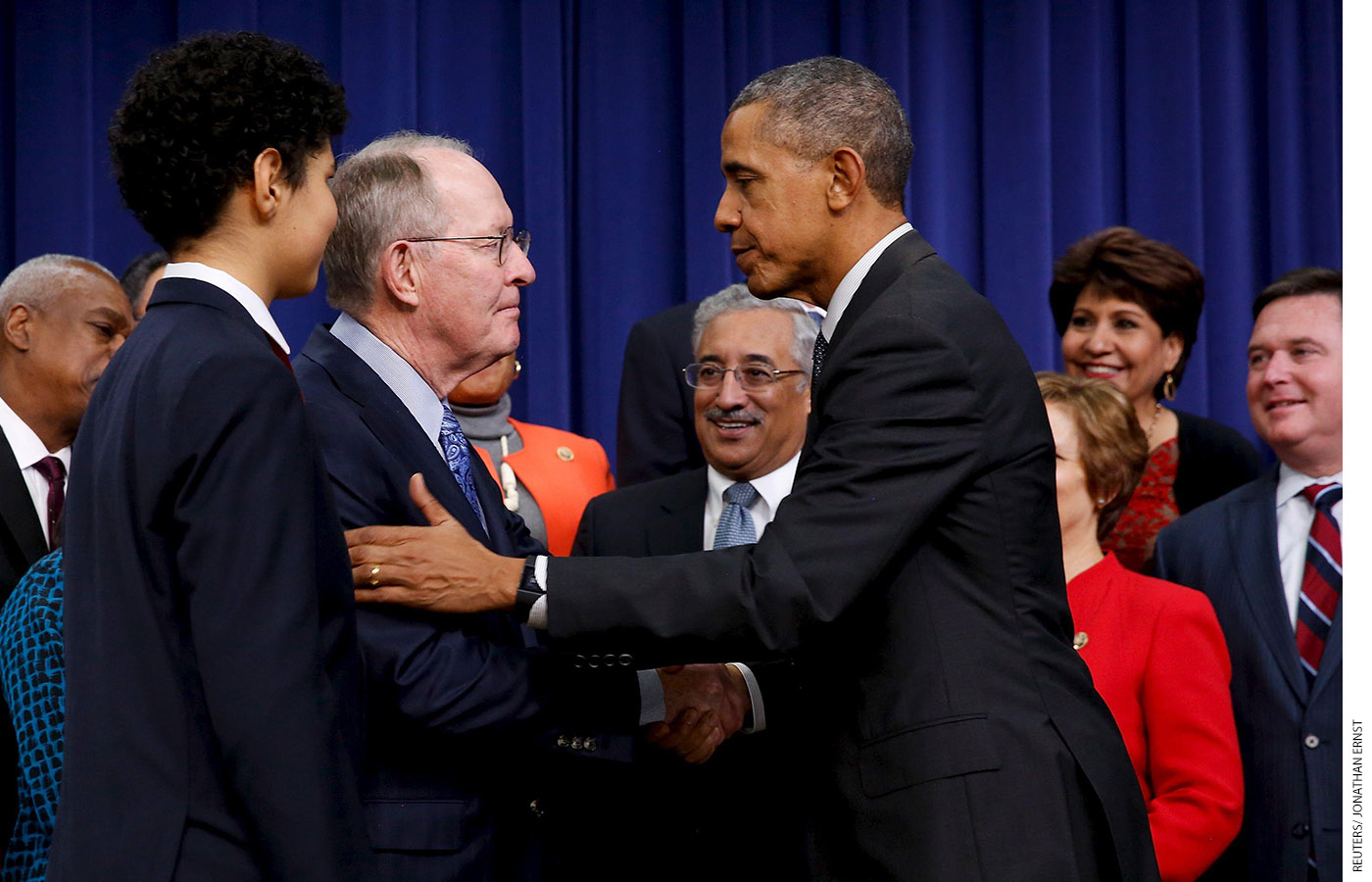
From Lamar’s standpoint, the slide toward a “national school board” had been arrested, indeed substantially reversed. And for this accomplishment he was praised from many directions. The Wall Street Journal termed it “the largest devolution of federal control to the states in a quarter-century.” The National Governors Association conferred on Lamar its first James Madison Award, in recognition of work that “epitomizes the type of cooperative federalism the founding fathers envisioned and governors expect,” in the words of association chair and Utah governor Gary Herbert. More surprisingly, the National Education Association, which two decades earlier had condemned Governor Alexander’s Master Teacher Program, conferred on him and Senator Murray its 2016 Friend of Education Award. NEA president Lily Eskelsen Garcia stated that “they were instrumental not only in the passing of the critical K–12 federal education law, but they listened, they set the tone of bipartisan cooperation, and they got the job done on behalf of the nation’s students and educators.”
Lamar didn’t stop there. The HELP Committee under his leadership churned out dozens of bills that made it into law, including a major overhaul of federal support for vocational education. In 2019, he undertook a heroic—though so far unsuccessful—effort to revamp and renew the Higher Education Act. In 2020, with the coronavirus pandemic sweeping the land, he became more engaged than ever in the health side of the committee’s portfolio.

Over the decades, Lamar has often quoted a maxim of the late Alex Haley, author of Roots: “Find the good and praise it.” In reflecting on the course of K–12 education in the United States over his decades of involvement with it, Lamar tends to see the good and celebrate it. Yet, he also recognizes how limited are the gains the country has made so far, how implacable is the resistance to change, and how complacent (or oblivious) are many communities toward shortcomings in their schools and their children’s achievement. He’s keenly aware of the limits on what Washington can—and should—do to rectify this, the more so at a time of intense partisanship. But no change occurs without foresight, leadership and stick–to-it-iveness, whether at the federal, state, community, or school level. And as governor, leader of governors, university president, education secretary, senator, and skilled navigator through the shoals of power, Lamar Alexander has achieved much of lasting worth.
See a few urgent needs and develop a strategy to meet each of them. Then stick with it until at least half the people agree that it’s right. Not a bad definition of leadership. And a noteworthy, durable legacy for a great American education reformer.
Chester E. Finn, Jr., is a Distinguished Senior Fellow and President Emeritus at the Thomas B. Fordham Institute. He is also a Senior Fellow at Stanford’s Hoover Institution.
The post Leadership Makes a Difference: Lamar Alexander and K–12 Education appeared first on Education Next.
more news https://northdenvernews.com
No comments:
Post a Comment